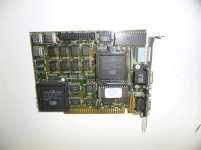stangman517
Experienced Member
Hello all.
I received a Video Seven VGA card from eBay and cosmetically it looks great. However I get nothing on my VGA monitor when powering up the computer. Typically I'd see the monitor show signs of life when first powering up, but not with this Video Seven card.
I checked the FCC Id against the one on minuszerodegrees and it matches: http://www.minuszerodegrees.net/5150/vga/5150_vga.htm I know the MB (5150 series B with the newest BIOS) has its dip switches set correctly because I pulled a HERCULES GB500 VGA 8 BIT ISA ADAPTER from my 5150 to test this Video Seven card. I also verified the switches on the Video Seven card match what's in the above link.
What I did notice is the author wrote "ou must not assume that all Video Seven VEGA VGA cards work in a 5150. It could be, for example, that a design change in later revisions of the card results in 5150 incompatibility." I noticed on the card I received the white label on the chip has different numbers as if mine is newer because the number(s) is higher. Plus in the author's image of the card I do not know what XT slot 8 means.
I have attached a pic of my card. If anyone has any ideas I would be greatly appreciative, and what does XT slot 8 mean?
Thank you!
I received a Video Seven VGA card from eBay and cosmetically it looks great. However I get nothing on my VGA monitor when powering up the computer. Typically I'd see the monitor show signs of life when first powering up, but not with this Video Seven card.
I checked the FCC Id against the one on minuszerodegrees and it matches: http://www.minuszerodegrees.net/5150/vga/5150_vga.htm I know the MB (5150 series B with the newest BIOS) has its dip switches set correctly because I pulled a HERCULES GB500 VGA 8 BIT ISA ADAPTER from my 5150 to test this Video Seven card. I also verified the switches on the Video Seven card match what's in the above link.
What I did notice is the author wrote "ou must not assume that all Video Seven VEGA VGA cards work in a 5150. It could be, for example, that a design change in later revisions of the card results in 5150 incompatibility." I noticed on the card I received the white label on the chip has different numbers as if mine is newer because the number(s) is higher. Plus in the author's image of the card I do not know what XT slot 8 means.
I have attached a pic of my card. If anyone has any ideas I would be greatly appreciative, and what does XT slot 8 mean?
Thank you!

